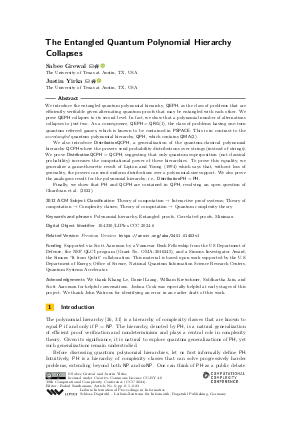LIPIcs.CCC.2024.6.pdf
- Filesize: 0.88 MB
- 23 pages

 Creative Commons Attribution 4.0 International license
Creative Commons Attribution 4.0 International license

We introduce the entangled quantum polynomial hierarchy, QEPH, as the class of problems that are efficiently verifiable given alternating quantum proofs that may be entangled with each other. We prove QEPH collapses to its second level. In fact, we show that a polynomial number of alternations collapses to just two. As a consequence, QEPH = QRG(1), the class of problems having one-turn quantum refereed games, which is known to be contained in PSPACE. This is in contrast to the unentangled quantum polynomial hierarchy, QPH, which contains QMA(2). We also introduce DistributionQCPH, a generalization of the quantum-classical polynomial hierarchy QCPH where the provers send probability distributions over strings (instead of strings). We prove DistributionQCPH = QCPH, suggesting that only quantum superposition (not classical probability) increases the computational power of these hierarchies. To prove this equality, we generalize a game-theoretic result of Lipton and Young (1994) which says that, without loss of generality, the provers can send uniform distributions over a polynomial-size support. We also prove the analogous result for the polynomial hierarchy, i.e., DistributionPH = PH. Finally, we show that PH and QCPH are contained in QPH, resolving an open question of Gharibian et al. (2022).
Feedback for Dagstuhl Publishing